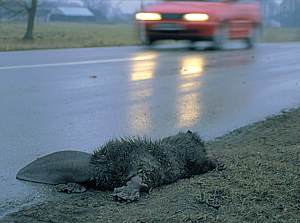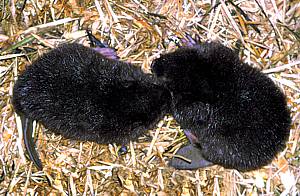|
BEAVERS
|
||||||||||||
Text:
|
Beavers in Wigry National Park
The European beaver is the most characteristic species of Wigry National Park (WNP). The first beaver site located within the current boundaries of the Park was described between 1944-1949 and located by the Czarna Hańcza river mouth leading from lake Wigry. In order to protect the new beaver families settling down at the shores of lakes and rivers in WNP, two partial reservations were established in 1959 and 1962. The first one, "Beavers' Refuge in Stary Folwark" covers the area of 120 ha. and encompasses the Czarna Hańcza river mouth leading from lake Wigry. The second reserve, "Zakąty Beavers' Refuge" was established near the village of Zakąty in 1962. It covers the area of 7 ha. The long-term protective measures, such as the foundation of the reservation, as well as the creation of Wigry National Park, contributed to the increase of the numerical force of those animals and facilitated their migration to neighbouring areas, resulting in the development of a population of thousands of beavers in Suwalki region.
During the first half of the 1990's, the numerical force of beavers in the Park oscillated around 250 individuals and has remained at this level until today. Such stable size of the population proves that the animals have occupied all the possible water bodies and watercourses. The inventory taking conducted by the staff of Wigry National Park has shown that the area of the Park is inhabited by 64 beaver families. Knowing that one site is usually inhabited by 4 beavers, 250 beavers were assumed to live here. The hydrographical network of the Park provide beavers with a diversified environment. Apart from drainage ditches, which are inhabited sporadically in the wooded water areas, most of the beavers occupy large lakes and rivers. The largest and longest watercourse, the Czarna Hańcza river, has been inhabited by as many as 8 beaver families. A 15- kilometre long section of this river is located in the area of WNP, and such a great number of animals on this relatively short watercourse proves that beavers, having "saturated" all possible water environments, focus on the most attractive areas with a rich food base. The high concentration of their population in WNP forced the animals to leave the afforested sites and settle in field areas.
Man-made drainage canals and ditches made the task easy for them. In the modern landscape, the field beaver sites link the groups of the once dispersed population into one entity. In the area of the Park there are 4 beaver families that adapted to the transformed environment by inhabiting drainage ditches and small field water bases. Occasionally, beavers establish their settlements within the close neighbourhood of man. It should be expected that such areas, rich in food during winter, will be attractive settlement spots for the other migrating animals. In order to provide themselves with the proper water depth and to facilitate moving and transporting food, beavers create floodings, which resulted in 84 registered beaver dams in the area of WNP. A relatively high number of 25 dams were built in the northern part of Park, on Wiatrołuża river. Some of them are of rarely seen, interesting construction. On the most shallow sections with a relatively swift current, the dams have been built of stones. Due to limited amounts of the traditional materials, such as branches and mud, the stone dams a truly interesting construction.
Beaver's habitats are used by many other animal species in the area of the Wigry National Park. It has been repeatedly noticed that beaver sites are becoming inhabited by the American mink. Otters are also frequent residents of beaver lodges. One case was reported of a beaver lodge inhabited by both a beaver and an otter at the same time. Beaver ponds are eagerly visited by many bird species, e.g. black stork, crane or kingfisher.
The present concentration of beavers within the area of the Park is 43 inhabited sites per 100 km2. Because of such a high number of beaver families, the population of beavers in WNP is beginning to suffer from the phenomenon characteristic of over-concentrated populations - increased competition and the migrations that follow it lead to the increased mortality rate of these animals. Moreover, the frequent contacts between individuals also have a negative effect due to a higher parasitation ratio. Internal parasites (trematodes) weaken the animals and often cause their death. Beavers also die in result of being trapped under ice, run over by a car or of mortal wounds acquired during a fight over the family area. The natural reduction of beaver population by predators is relatively small in the Park. The low concentration of large predators cannot be the reason for great losses among beavers. The Słupie Protection District is the only place where killings of whole beaver families by wolves were recorded.
The current number of beavers, complex hydrographical network of the Park and the environmental diversity provide ideal conditions for conducting research and observations of this interesting rodent. WNP, in co-operation with scientific institutions and organisations, conducts a number of study programmes on the functioning of the freely existing populations of those animals. Apart from the scientific achievements regarding the biology and ecology of beavers, the conducted research programmes, the researched master's theses and the observations carried out by enthusiasts of nature result in the thorough discernment of the influence of these animals on man's economy.
European beaver is the coat of arms of the Wigry National Park, as it will remain a permanent element of the Park. When roaming the tourist routes, one can often observe the signs of beavers' activity or, provided they remain silent and calm, even see them swimming and feeding. Once they find a safe refuge, the beavers are also active during the day. In order to facilitate the observations of beavers, a special platform was prepared on the "Suchary" educational path. Nature lovers who have not been able to see these interesting creatures live can see them on film in the building of the Wigry National Park Management Headquarters.
|
|||||||||||
|
|
|





